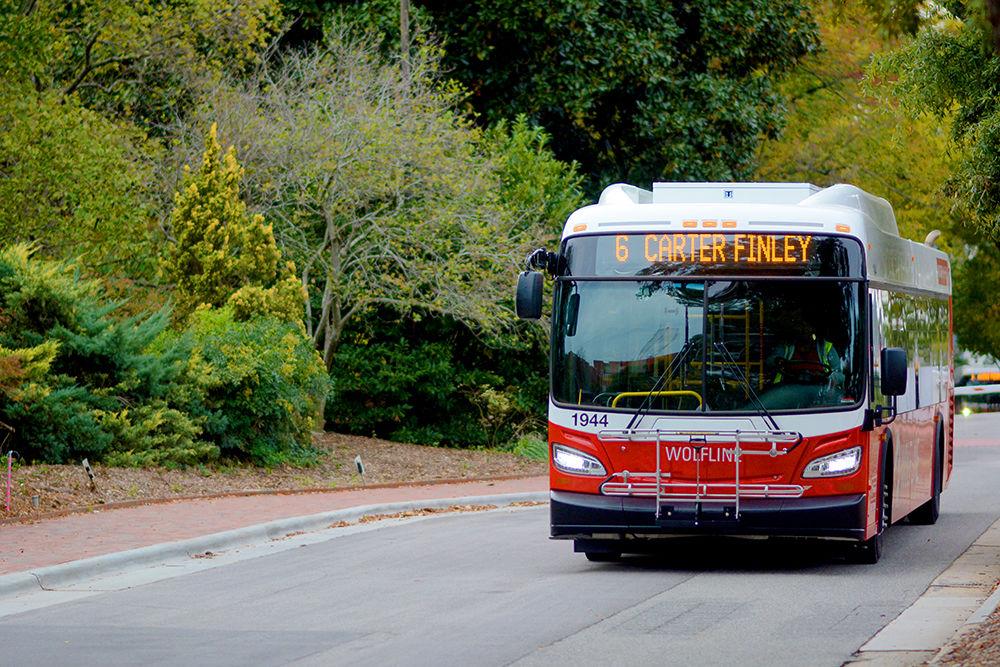
Emma Vawter
NC State's Wolfline buses provide transportation for students and the general public. The buses were produced to additionally provide transportation to football and basketball games at Carter Finley Stadium and PNC Arena.
NC State’s Wolfline bus system services thousands of rides per day. Through a data-driven approach, the system constantly tracks bus usage trends and changes, as evident in the recently created park-and-ride Spring Hill lot and the planned reallocation of a bus from Route 6: Carter Finley to Route 7: Wolflink Shuttle.
Statistics provided by NCSU Transportation show that Route 1: Avent Ferry and Route 3: Engineering have, by far, the highest utilization. In Sept. 2019, the routes received 3,875 and 4,009 rides per weekday on average, respectively. These figures are fairly similar to ridership seen in Sept. 2018.
Most other routes receive under half the ridership of these routes, but according to Byron Bryant, transit manager at NCSU Transportation, this is not to say these routes are without their purposes.
For instance, Route 2: Spring Hill, according to the NCSU Transportation website, has stops at Wolf Ridge apartments, Carmichael Gym, the Wilson College of Textiles and importantly, the Spring Hill park-and-ride lot. Students are able to park their cars in the lot and take the Route 2 bus to campus.
Bryant said that for its first year, the route has been used well, with average weekday ridership at just under 1,000.
“In fact, it’s not nearly as popular as it would be, if there wasn’t a lot of illegal parking going on at the Holy Name of Jesus cathedral,” Bryant said. “I was quite surprised to see the number of students parking there and crossing Centennial Parkway, primarily engineering students.… The utilization of the parking lot at Spring Hill seems to be right around 75-80%, so it’s not full, but it’s definitely doing very well for its very first semester in existence.
Bryant said because of the data collected on bus utilization, the Wolfline system will see some changes in the near future.
“Based on this analysis, we will be discontinuing the overflow bus that operates on Route 6 and we’ll actually be reallocating that to Route 7,” Bryant said. “So Route 7, in the spring, will have an overflow bus from approximately 8 a.m. to 10:30 a.m. So again, addressing those most important class times where everybody’s coming to campus and ridership demand is at its highest.”
The overflow buses, Bryant said, operate at peak hours, when demand is high. For instance, overflow buses may be deployed for Route 3, to keep up with demand in the mornings for students making their way to and from Centennial campus.
“The overflow buses are really to mitigate leaving behind anyone,” Bryant said. “The most important thing, obviously, we’re here to serve the community in general, but primarily the service is directed toward getting folks to class.”
Route 3 specifically has spikes in ridership throughout the day, matching common class times, such as 9:30 a.m. and 11:30 a.m. Bryant said that these spikes are consistent with the nature of Route 3. The route also has a far shorter loop than most others, which, combined with its general popularity, lead to it servicing just over 80 passengers per hour, Bryant said.
Route 1, on the other hand, has no distinct pattern to its use, nor does it have a short loop. As a result, it stays relatively popular throughout the day, according to Bryant.
Bryant said that one of the most significant recent impacts on the Wolfline has been the construction of a new apartment complex, The Station, which lies along Route 6: Carter Finley. The route has seen a massive ridership increase. On an average weekday in Sept. 2018, route six would get 604 rides, but this increased to 1082 rides in Sept. 2019.
“They were opening this new apartment complex, right along the route, probably the reason they purchased the land and built the thing there, which is interesting,” Bryant said. “This is the result of them building that apartment complex: there was a 79% increase in ridership on the Route 6 that goes by that complex, and it is almost solely due to that complex being built there.”
Purely going off statistics, Bryant said that Route 11: Village Link is the least effective. According to the NCSU Transportation website, the route serves to connect western parts of main campus, such as Wolf Village, E. S. King apartments and the West Deck parking lot with Centennial Campus. As such, Bryant said, it’s understandable it doesn’t reach levels of ridership that Route 3 or Route 1 have.
“It has a very specific service it’s providing to a very specific group of Wolf Village folks, and now we redesigned it a few semesters ago,” Bryant said. “But, that being our worst performing route, or at least our lowest ridership route, remember that passenger per hour number I mentioned. That bus, even though it’s our worst performing route, ridership-wise, has 25.7 passengers per hour, which any city agency would love to have.”
Bryant said that the Wolfline has a 45-bus fleet, and at peak, 38 of these buses are running during the daytime, while four run during the night. During the day, Bryant said that there are seven reserved buses not operational to ensure backups are available.
“If you plan to run all 45, and one breaks down, or you need to hold two in because it’s time for their oil change, now you’re not operating scheduled service, because of normal stuff that happens,” Bryant said. “Believe it or not, people run into buses, unfortunately, buses run into things. Those things happen.”
Further information about the Wolfline can be found on NCSU Transportation’s website. Live information about routes can be found on the TransLoc website, as well as the TransLoc app, available for iPhone and Android devices.